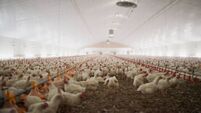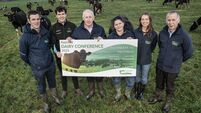White-tailed eagle shooting condemned

One of the resident adult white-tailed eagles on Lough Lein at Killarney National Park. Picture: Valerie O'Sullivan / NPWS
The shooting dead of a two-year-old female white-tailed eagle at Lough Owel, near Mullingar in Co Westmeath last month shocked nature lovers countrywide and was widely condemned as a deplorable act.
It was particularly regretted in the Shannon Estuary, where she was released in 2022 as part of a re-introduction programme for the endangered species by the National Parks and Wildlife Service in partnership with the Norwegian Institute for Nature Research.
There was also sadness in the north Kerry countryside, where the stunning bird of prey spent her first year of freedom travelling across the landscape.
Like all white-tailed eagle chicks released into the environment, she was fitted with a satellite tag which showed that she left north Kerry in early 2023 and travelled widely across the country.
She spent time in Donegal and made trips over and back to north Antrim, Fermanagh, Cavan and other counties, including visiting Lough Ree in the north midlands.
After moving to Westmeath, she moved between local lakes, including Lough Owel, where she was found shot dead on December 6, the day before Storm Darragh.
White-tailed eagles, a protected species under the Wildlife Act, are treasured by local communities and visitors to Ireland alike and any loss resonates throughout, according to the NPWS.
A thorough investigation into her death is being led by the Wildlife Crime Directorate with the support of the Gardaí. The NPWS has urged anyone with information relating to the incident to assist.
The NPWS condemned the deliberate killing of rare and endangered species. It said it takes bird of prey persecutions extremely seriously and is appealing for any information the public may have in relation to the latest incident.
Malcolm Noonan, the then Minister of State for Nature and Heritage, said: “White-tailed eagles are magnificent creatures; their presence are such good indicators of the health of our ecosystems and countryside and now part of our wider efforts to restore nature. It is an absolutely deplorable act to kill such a rare and endangered species.”
Working together, the NPWS, Regional Veterinary Laboratories (DAFM), and the State Laboratory introduced a formal protocol for investigating Irish bird of prey deaths in 2011. Known as the RAPTOR (Recording and Addressing Persecution and Threats to Our Raptors, it is currently being updated.
Taoiseach Michéal Martin, the then Tánaiste, speaking at Killarney National Park last August, when four white-tailed eagle chicks were released into the wild, said witnessing these majestic birds in their natural habitat was a remarkable experience.
“I’ve been following this re-introduction programme with real interest since the first chicks were released here at the park in 2007. The white-tailed eagle is an important part of our biodiversity, but also our heritage.
“Their re-appearance in our skies is a source of wonder and interest for local and international visitors to Killarney National Park,” he said, thanking the NPWS staff, landowners and international partners from Norway for their work on the programme.
“We are all invested in the survival of these rare and beautiful birds and have a part to play in keeping them safe,” he said.
In 2020, the National Parks and Wildlife Service began a second phase white-tailed eagle re-introduction project to bolster the existing eagle population in Ireland.
The original programme (2007-2011) involved releasing 100 young white-tailed eagles in Killarney National Park. The released eagles subsequently dispersed widely throughout Ireland, with the first successful breeding occurring in 2012 in Lough Derg, Co Clare.
By July 2020, a small breeding population of eight to 10 pairs had successfully fledged 31 chicks across counties Cork, Kerry, Clare, Galway and Tipperary.
Some Irish-bred eagles are now reaching maturity and starting to breed in the wild. However, a scientific review of the re-introduction project indicated the small population is still vulnerable to mortality factors such as Avian Influenza, illegal poisoning and extreme weather events.
The NPWS says an important aspect of any such release is co-operation with the farming communities in the release areas and where birds settle to breed. Farmers help to monitor birds and nests at some nesting sites.
As well as bringing biodiversity and ecosystem benefits, restoring this flagship species is seen to deliver potential economic benefits to local communities.
The re-establishment of breeding white-tailed eagles at sites like Glengarriff, Lough Derg, and Killarney National Park has proven hugely popular with residents and visitors.












